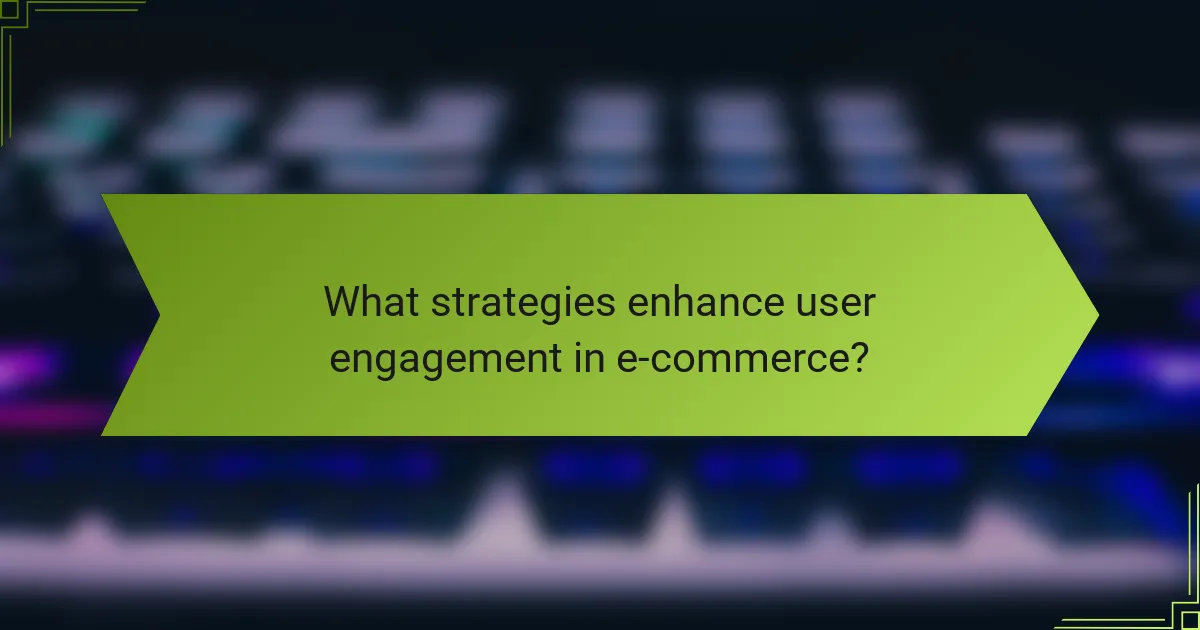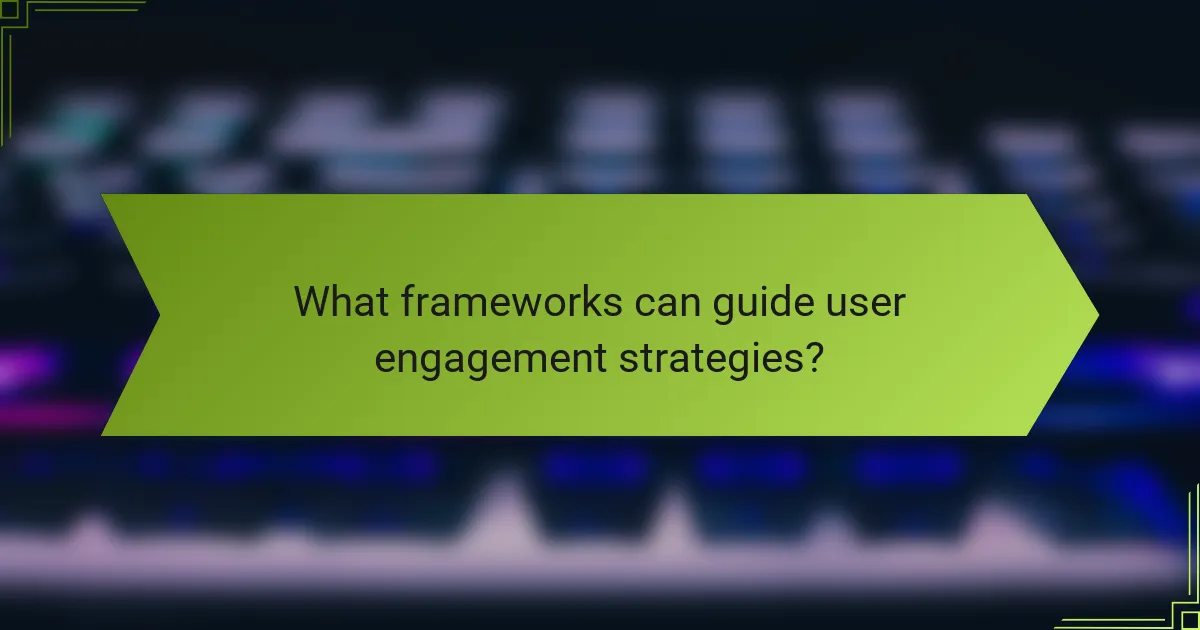User engagement is a critical component of successful digital marketing, encompassing various techniques that not only capture attention but also encourage meaningful interactions. By leveraging methods such as interactive content, personalization, and gamification, businesses can create a more engaging experience for their audience. Additionally, measuring user engagement through a mix of quantitative and qualitative metrics allows organizations to refine their strategies and enhance customer satisfaction.

What techniques improve user engagement in digital marketing?
Improving user engagement in digital marketing involves utilizing various techniques that capture attention and foster interaction. Effective methods include interactive content, personalization strategies, gamification elements, social media integration, and email marketing optimization.
Interactive content
Interactive content, such as quizzes, polls, and calculators, encourages users to actively participate rather than passively consume information. This type of content can significantly increase engagement by making the user experience more enjoyable and memorable.
To implement interactive content, consider tools that allow easy integration into your website or social media platforms. For example, a simple quiz related to your product can provide valuable insights while keeping users engaged for longer periods.
Personalization strategies
Personalization strategies tailor content and experiences to individual user preferences, enhancing relevance and connection. Techniques include using data analytics to segment audiences and deliver customized messages based on user behavior and demographics.
For effective personalization, utilize customer relationship management (CRM) systems to track user interactions. Personalized email campaigns that address users by name and recommend products based on past purchases can lead to higher engagement rates.
Gamification elements
Gamification incorporates game-like features, such as points, badges, and leaderboards, into marketing strategies to motivate user participation. This approach taps into users’ competitive instincts and can make mundane tasks more enjoyable.
To apply gamification, consider creating a loyalty program that rewards users for completing specific actions, like sharing content or making purchases. This not only boosts engagement but also encourages repeat interactions with your brand.
Social media integration
Integrating social media into your marketing strategy enhances user engagement by facilitating sharing and interaction. Platforms like Facebook, Instagram, and Twitter allow users to connect with your brand and each other, creating a community around your products or services.
To maximize social media integration, ensure your content is easily shareable and encourages user-generated content. Running contests or campaigns that prompt users to share their experiences can significantly increase visibility and engagement.
Email marketing optimization
Email marketing optimization involves refining email campaigns to improve open rates and user interaction. Techniques include A/B testing subject lines, segmenting your audience, and personalizing content based on user behavior.
To enhance email marketing effectiveness, focus on crafting compelling subject lines that entice users to open the email. Regularly analyze metrics such as click-through rates and adjust your strategies accordingly to maintain high engagement levels.

How can businesses measure user engagement effectively?
Businesses can measure user engagement effectively by utilizing a combination of quantitative and qualitative metrics that reflect user interactions and satisfaction. Key performance indicators (KPIs) and engagement metrics tools provide insights into how users interact with content, helping organizations refine their strategies.
Key performance indicators (KPIs)
Key performance indicators (KPIs) are essential for assessing user engagement. Common KPIs include session duration, page views per visit, bounce rate, and conversion rate. These metrics help businesses understand user behavior and identify areas for improvement.
For example, a high bounce rate may indicate that users are not finding the content relevant or engaging. Conversely, a longer session duration typically suggests that users are interested in the content and are exploring more pages.
Engagement metrics tools
Engagement metrics tools are software solutions that help businesses track and analyze user interactions. Popular tools include Google Analytics, Mixpanel, and Hotjar, each offering unique features for measuring user engagement. Google Analytics provides comprehensive traffic analysis, while Mixpanel focuses on user actions and retention.
Using these tools, businesses can set up custom dashboards to monitor specific metrics. For instance, tracking user flow can reveal how visitors navigate through a website, allowing for targeted optimizations to enhance user experience.
Analytics platforms comparison
When comparing analytics platforms, consider factors such as ease of use, integration capabilities, and the depth of insights provided. Google Analytics is widely used for its robust features and free tier, making it accessible for small businesses. In contrast, platforms like Adobe Analytics offer advanced capabilities but may come with higher costs.
For businesses looking for real-time data and user segmentation, Mixpanel stands out as a strong option. A simple comparison table can help visualize the strengths of each platform:
| Platform | Cost | Key Features |
|---|---|---|
| Google Analytics | Free / Paid | Traffic analysis, audience insights |
| Mixpanel | Paid | User actions tracking, retention analysis |
| Adobe Analytics | Paid | Advanced segmentation, custom reporting |

What strategies enhance user engagement in e-commerce?
Effective strategies to enhance user engagement in e-commerce include personalized product recommendations, customer feedback loops, live chat support, and abandoned cart recovery techniques. Implementing these strategies can significantly improve customer interaction, satisfaction, and ultimately, sales.
Product recommendations
Product recommendations leverage user data to suggest items that align with individual preferences. By analyzing browsing history, past purchases, and customer behavior, e-commerce platforms can present tailored suggestions that increase the likelihood of additional sales.
Consider using algorithms that rank products based on popularity or user ratings. A/B testing different recommendation placements on your site can help identify the most effective strategies for your audience.
Customer feedback loops
Establishing customer feedback loops involves actively seeking and incorporating user opinions to improve products and services. This can be achieved through surveys, reviews, or direct communication channels, allowing customers to feel valued and heard.
Implementing regular feedback requests after purchases or interactions can help gather insights. Ensure to acknowledge feedback publicly, which can enhance trust and encourage more customers to share their thoughts.
Live chat support
Live chat support provides immediate assistance to customers, improving their shopping experience and reducing frustration. By offering real-time help, you can address queries, resolve issues, and guide users through the purchasing process.
Consider using chatbots for common inquiries while ensuring human agents are available for complex issues. This combination can enhance efficiency and user satisfaction, leading to higher conversion rates.
Abandoned cart recovery
Abandoned cart recovery strategies aim to re-engage customers who leave items in their shopping carts without completing a purchase. Techniques include sending reminder emails or offering discounts to encourage them to finalize their transactions.
Timing is crucial; sending reminders within a few hours of abandonment can yield better results. Consider personalizing these messages with the specific items left behind to increase the chances of recovery.

What are the best practices for increasing user engagement in mobile apps?
To enhance user engagement in mobile apps, focus on personalized experiences, timely communication, and intuitive navigation. Implementing effective strategies such as push notifications, user onboarding processes, and in-app messaging can significantly boost user retention and satisfaction.
Push notifications
Push notifications are brief messages sent to users’ devices to encourage interaction with the app. They should be relevant and timely, providing value without overwhelming users. Aim for a balance; sending too many notifications can lead to user fatigue and app uninstalls.
To optimize push notifications, segment your audience based on behavior and preferences. For example, sending a special offer to users who haven’t engaged in a while can rekindle interest. Use A/B testing to determine the best times and content for notifications.
User onboarding processes
User onboarding is the initial experience that guides new users through your app’s features and benefits. A well-designed onboarding process can increase retention rates significantly by helping users understand how to use the app effectively. Keep it concise and engaging, ideally lasting no more than a few minutes.
Consider using interactive tutorials or walkthroughs that allow users to explore the app while learning. Avoid overwhelming users with too much information at once; instead, introduce features gradually as they become relevant to their usage.
In-app messaging
In-app messaging allows for real-time communication with users while they are actively using the app. This can include tips, updates, or personalized offers that enhance the user experience. Ensure that messages are contextually relevant to avoid disrupting the user’s flow.
Utilize in-app messaging to gather feedback or conduct surveys, which can provide valuable insights into user preferences. Keep messages concise and actionable, and consider implementing a way for users to dismiss or opt-out of messages to maintain a positive experience.

What frameworks can guide user engagement strategies?
User engagement strategies can be effectively guided by frameworks such as the engagement funnel model and customer journey mapping. These frameworks help businesses understand user behavior and optimize interactions to enhance overall engagement.
Engagement funnel model
The engagement funnel model outlines the stages users go through from awareness to conversion and retention. It typically includes stages like awareness, interest, consideration, intent, evaluation, and purchase, allowing businesses to tailor their strategies at each point.
To implement this model, identify key metrics for each stage, such as website traffic for awareness and conversion rates for purchase. Regularly analyze these metrics to identify drop-off points and adjust your strategies accordingly.
Common pitfalls include neglecting the post-purchase stage, which is crucial for retention. Focus on nurturing existing customers through personalized communication and loyalty programs to maximize lifetime value.
Customer journey mapping
Customer journey mapping visualizes the complete experience a user has with a brand, from initial contact to post-purchase interactions. This framework helps identify pain points and opportunities for improvement across various touchpoints.
To create an effective journey map, gather data from customer feedback, analytics, and user testing. Highlight key stages such as awareness, consideration, purchase, and post-purchase, and note the emotions and challenges users face at each stage.
Ensure that your mapping process is iterative; regularly update it based on new insights and changing user behaviors. This adaptability will help maintain relevance and enhance user engagement over time.

How does user engagement impact conversion rates?
User engagement significantly influences conversion rates by determining how effectively users interact with a website or application. Higher engagement often leads to increased trust and interest, which can translate into more conversions, such as purchases or sign-ups.
Correlation with sales
The correlation between user engagement and sales is evident in various metrics, such as time spent on site and interaction rates. Engaged users are more likely to explore products, read reviews, and ultimately make a purchase. For instance, e-commerce sites often see a noticeable increase in sales when users spend more than a few minutes browsing.
To enhance this correlation, businesses should focus on creating engaging content and intuitive navigation. Simple strategies like personalized recommendations or interactive elements can keep users interested and encourage them to complete purchases. A well-designed user experience can lead to conversion rates that are significantly higher than average.
Monitoring key performance indicators (KPIs) such as bounce rates and average session duration can provide insights into user engagement levels. Regularly analyzing these metrics helps identify areas for improvement, ensuring that user engagement remains high and positively impacts sales outcomes.
